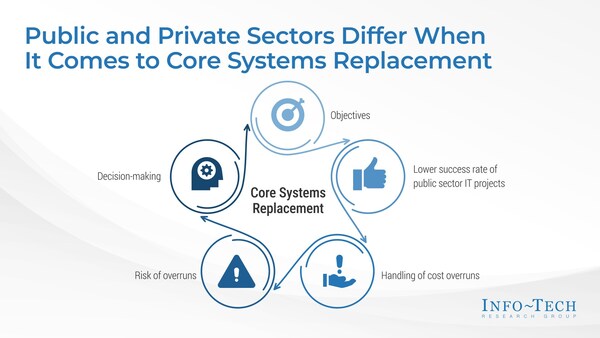Info-Tech Research Group has published new insights for IT leaders navigating core system replacements in government. The firm’s comprehensive resource highlights the importance of adopting a holistic approach and a strategic shift-left mindset to address the unique challenges the public sector faces. Info-Tech’s data-driven blueprint outlines forward-thinking strategies that can streamline IT transformations, improve operational efficiency, and foster sustainable innovation in the public sector.
TORONTO, Aug. 22, 2024 /PRNewswire/ – Government organizations face significant challenges when replacing their core systems, including cost overruns, governance issues, resistance to change, and a lack of technical expertise. Unlike the private sector, these challenges require specialized approaches tailored to the unique needs of government projects. Info-Tech Research Group’s latest blueprint, Core Systems Replacement in Government, identifies five critical distinctions between the public and private sectors in core system replacement, highlighting the need for customized strategies. The research-backed resource details the importance of a holistic approach, combined with a strategic shift-left mindset, in significantly improving success rates, enhancing project outcomes, and elevating stakeholder satisfaction.

Info-Tech’s blueprint provides insights for IT leaders in the public sector, emphasizing the importance of understanding the full tools and packages they are acquiring when replacing core systems. Outdated core systems can pose significant challenges for governments by limiting agility, hindering innovation, increasing operating costs, and creating incompatibilities within the technology stack and applications. The firm advises that addressing these limitations is critical to enabling government organizations to respond quickly to events, adopt new technologies, and meet customer expectations.
In its newly published resource, Info-Tech outlines the benefits of adopting a strategic shift-left mindset for core system replacements in government. The “shift-left” approach focuses on identifying and resolving issues early in the development process. By prioritizing early testing, feedback, and collaboration, potential problems can be addressed before they escalate into costly disruptions.
“While a holistic strategy provides a solid foundation for core system replacement projects, it may not address all potential challenges that can arise during the implementation process,” says Patrick Spencer, research fellow at Info-Tech Research Group. “This is where the strategic shift-left mindset becomes crucial. This proactive approach requires involving key collaborators from the outset, conducting thorough risk assessments, and implementing agile project management practices to adapt to changing requirements and circumstances.”
In the Core Systems Replacement in Government blueprint, Info-Tech details five key distinctions between the public and private sectors when it comes to replacing core systems, highlighting the need for a unique approach.
- Objectives: While private sector organizations primarily focus on economic goals, public sector projects must balance both economic and policy objectives. Public sector projects often face challenges in aligning stakeholders on strategy and prioritization, especially over long periods. Policy volatility, particularly during government changes, can disrupt alignment and cause conflicts with the original project goals, undermining previous efforts.
- Lower success rate of public sector IT projects: Public sector IT projects are at greater risk of exceeding their initial cost and time estimates due to several factors. These include a more complex landscape of decision-makers, less effective risk management practices, difficulties in attracting and retaining skilled personnel, slower governance processes, and less pressure to deliver minimum viable products. As a result, public sector projects tend to have a lower success rate compared to private sector initiatives.
- Handling of cost overruns: A major distinction between the two sectors is how they manage projects that go over budget. Private sector companies often have established procedures for terminating unsuccessful projects, whereas the public sector may lack such processes, leading to projects continuing despite cost overruns.
- Risk of overruns: Public-sector IT projects are more prone to budget and timeline overruns than private-sector projects. Research shows that eight out of ten public sector IT projects exceed their timelines, with nearly half experiencing cost overruns. In contrast, only one in three private sector projects face such challenges. On average, public sector IT projects incur cost overruns nearly three times higher than those in the private sector.
- Decision-making: Decision-making in the private sector is typically handled internally, while public institutions must take public opinion into account, adding layers of complexity to the decision-making process.
By prioritizing early stakeholder involvement, proactive risk management, and alignment with organizational goals, Info-Tech’s blueprint offers IT leaders a framework to ensure smoother transitions and more successful outcomes in core system replacement in the public sector. This approach provides several benefits, including increased efficiency, reliability, and scalability, which lead to superior system performance and responsiveness. Additionally, streamlined processes, reduced maintenance costs, and optimized resource use contribute to significant long-term cost savings for governments.



